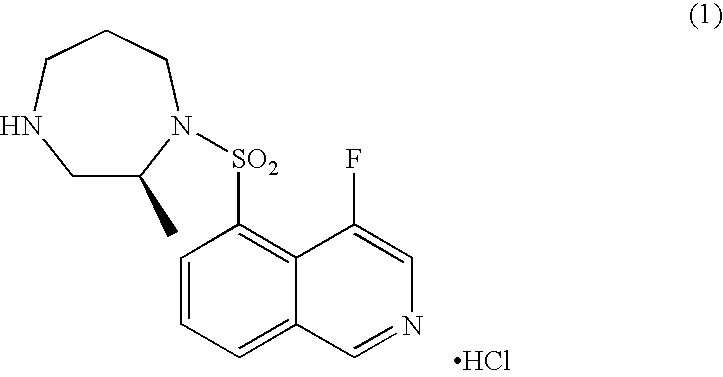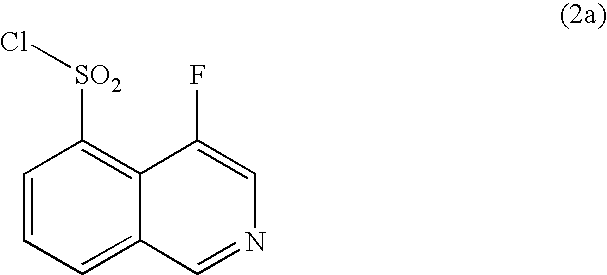Process for production of 4-fluoroisoquinoline-5-sulfonyl halide or salt thereof
- Summary
- Abstract
- Description
- Claims
- Application Information
AI Technical Summary
Benefits of technology
Problems solved by technology
Method used
Image
Examples
example 1
Production of 4-fluoroisoquinoline-5-sulfonyl chloride hydrochloride from 4-fluoroisoquinoline
[0041]To a 10-L-capacity reactor equipped with a stirrer, a thermometer, a condenser, and a dropper, 4-fluoroisoquinoline (750.0 g, 5.1 mol) which has been produced according to the method disclosed in the pamphlet of WO 99 / 20620 was placed. While internal temperature of the reactor was maintained at 10° C. to 30° C. under cooling with stirring, concentrated sulfuric acid (1,100 g, 11.2 mol) was added dropwise thereto. After completion of addition, the bath temperature was elevated to 40° C., and the mixture was stirred for 0.5 hours. Subsequently, under cooling and stirring, sulfuric anhydride (3,577.7 g, 44.69 mol as SO3) was added dropwise little by little to the reactor through a dropping funnel which had been maintained at 40° C., while the internal temperature of the reactor was maintained at 30° C. to 45° C., and the mixture was stirred at room temperature for 12 hours. After termina...
example 2
Production of 4-fluoroisoquinoline sulfuric acid salt
[0043]4-Fluoroisoquinoline (9.40 kg, 63.9 mol) was dissolved in acetone (35 L). Under stirring, sulfuric acid (6.58 kg, 67.1 mol) was added little by little carefully to the solution, while the internal temperature was maintained at 5±5° C., followed by stirring for two hours. The precipitated crystals were collected through filtration and washed with acetone (28 L), followed by drying under reduced pressure, to thereby yield 15.5 kg of 4-fluoroisoquinoline sulfuric acid salt (98.8%).
mp: 165.7 to 167.0° C.
[0044]IR(KBr) cm−1: 1659, 1617, 1601, 1558, 1506, 1407, 1377, 1288, 1245, 1225, 1145, 1069, 1025, 893, 867, 795, 781, 714.
1H-NMR (400 MHz, DMSO-d6) δ: 9.59(1H, s), 9.07(2H, brs), 8.78(1H, d, J=3.20 Hz), 8.49(1H, d, J=7.79 Hz), 8.27(1H, d, J=7.79 Hz), 8.16(1H, dd, J=7.79, 7.79 Hz), 8.01(1H, dd, J=7.79, 7.79 Hz)
example 3
Production of 4-fluoroisoquinoline-5-sulfonyl chloride hydrochloride from 4-fluoroisoquinoline sulfuric acid salt
[0045]To a 200-mL-capacity reactor equipped with a stirrer, a thermometer, a condenser, and a dropper, sulfuric anhydride (94.3 g, 1.18 mol) which had been liquefied through heating at 20° C. to 35° C. was added, and the internal temperature was adjusted to 26° C. to 34° C. While the internal temperature was maintained, 4-fluoroisoquinoline sulfuric acid salt (33.33 g, 0.136 mol) produced in Example 2 was gradually added to the reactor. Thereafter, the internal temperature of the reactor was adjusted to 30° C., and the content was stirred for 13 hours. Thionyl chloride (89.0 g, 0.75 mol) was added dropwise to the reaction mixture, followed by heating to 70° C. and stirring for four hours. After completion of reaction, the reactor was cooled.
[0046]Water (333 mL), ice (600 g), and methylene chloride (500 mL) were added to another reactor (capacity: 3 L), and the reactor was...
PUM
 Login to View More
Login to View More Abstract
Description
Claims
Application Information
 Login to View More
Login to View More - R&D
- Intellectual Property
- Life Sciences
- Materials
- Tech Scout
- Unparalleled Data Quality
- Higher Quality Content
- 60% Fewer Hallucinations
Browse by: Latest US Patents, China's latest patents, Technical Efficacy Thesaurus, Application Domain, Technology Topic, Popular Technical Reports.
© 2025 PatSnap. All rights reserved.Legal|Privacy policy|Modern Slavery Act Transparency Statement|Sitemap|About US| Contact US: help@patsnap.com



